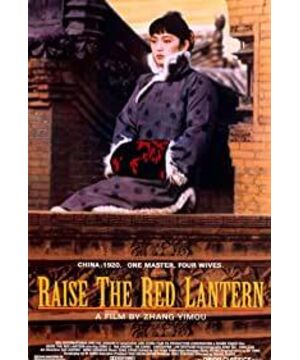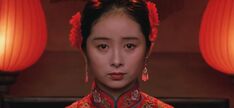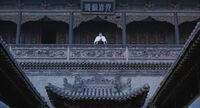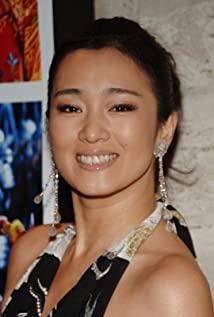"Raise the Red Lantern" is a film directed by Zhang Yimou and starring Gong Li. It mainly tells the story of the heroine, Song Lian, who was persecuted by feudal ethics after marrying into a wealthy family. It shows the director's concern for the low status of women in the old society. Sympathy, satire, and a critique of feudal customs.
As we all know, director Zhang Yimou has always been very particular about the use of audio-visual language, and this film is no exception.The sound is interspersed to create an atmosphere.
The close-up of Song Lian at the beginning of the film is mixed with the dialogue of Song Lian's mother as a voice-over. After the dialogue between the two ends, the sound is before the sound, and the gongs and drums of the welcoming team in the next panoramic shot are placed in front of the close-up of Song Lian's face. The emotions inside the painting are pushed out of the painting, following the audience's expectations, suggesting that Song Lian will marry into a wealthy family in the future. In the film, every time a red lantern is hung on the door of the concubine, the noise will be separated, but the sound of the hanging lantern is deliberately amplified to create a huge echo effect. It alludes to the dreary emptiness and lifelessness in this house, and it is also the origin of the struggle between the concubines. Like the echo of hanging lanterns, it appears as a background sound many times in the film. Throughout the film, there are the ringing bells while waiting for the concubine to beat her feet and the singing of the third wife, Mei Shan. The former, like the Echo, is a symbol of the concubine's impending favor, satirizing the Chen family's strict hierarchy and decadent family rules. The latter, according to the needs of the plot, used Mei Shan to sing different operas to reflect her inner thoughts at different times, set off the atmosphere of the Chen family at that time, and used the ethereal lyrics resounding in the empty courtyard to create a cautious atmosphere. alluding to the terror of feudal forces.The color arrangement hints at details.
The main color of the whole film is bright red, the overall tone is gray, and dark orange is used as the background. However, in the panoramic view of the house, blue-purple or dark gray are often used in cool tones to express a depressing atmosphere. Just like the title of the film, the red lantern hangs high, and red is the color of the clue in the film. The red lantern is the most important theatrical element in the film, as an image that implies desire. The lanterns in the film are not bright red, but more orange-red after the lanterns are lit, but they are eye-catching and dazzling because they are in the dark courtyard, just like Song Lian, a foreign student who has read a book. The arrival has become a thorn in the eyes of several other concubines. The fashion sense of the female characters in the film is also constantly changing with the development of time. Song Lian first appeared in a plain white floral jacket and a dark brown peony cheongsam, suggesting that she has grown from an independent and self-improving foreign student to being trapped in a deep house. The mentality of the concubine's scheming struggle was forcibly turned into an intrigue; the maid Yan'er also gradually changed from the pink clothes at the beginning to dark brown after the first time she was found to have lit the lamp privately. compromise. In such a gloomy feudal family, the women could only struggle with twists and destruction without redemption.
The composition pattern is deepened. and the composition method of the theme film is clear. The film opens with a close-up shot of a symmetrical composition. The neat set pattern hints at Songlian's well-behaved but tough character. Most of the shots walking through the Fuzhong are symmetrical and framed compositions, using thresholds to increase the depth of the shots, showing that women married into the Chen family stepped into the shadow of feudal forces step by step, trapped in it and unable to turn back. The panoramic shot of the Chen family compound from midair is also a very obvious framed composition, as if a coffin traps people in it. Especially at the end of the movie, Song Lian wanders around the yard and does not enter the house, which also implies that the people locked in this yard are unable to break free from the invisible shackles on their bodies and can never get out again. This panoramic aerial shot appears repeatedly in the film, mostly after sunset or at dusk, using cool tones to satirize the decay and backwardness of the Chen family system. Most of the framed compositions in the film have the same connotation, not only imprisoning women in marriage in the old society but also alluding to the heavy control of people by feudal ethics.
The use of scenes in this film is also ingenious. Taking Mr. Chen as an example, his performances in the whole film are mostly panoramic or medium shots, or his words are used as a voice-over to describe his image. A character who has never shown a face in the whole film can still have such a great influence and deterrent effect on the Chen family. This is to imply that the Chen family master is the epitome of the old society and the representative of the status of the master in the feudal class. Without deliberately shaping his image, he can use him to satirize all the masters like him in society.
Under the oppression of this cannibalistic dogma, unless you take every step of the way and do your best, you will only be a cocoon and take the blame. Humans and ghosts are only one breath away, but the old society forced people to become ghosts.View more about Raise the Red Lantern reviews











